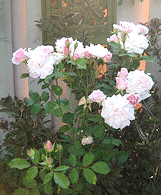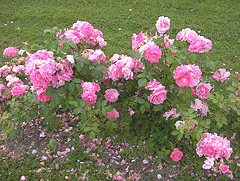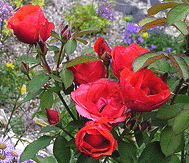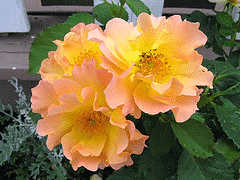Canadian Parkland Roses
Canadian Parkland Roses were developed to withstand the cold Canadian winters, but will also thrive in warm and humid summers. The Parkland roses are very easy to care for, needing minimal spraying for disease and insects. Although very hardy, the Parkland Series is not quite so cold hardy and disease resistant as the Canadian Explorer Series. However, they are “own root” plants, so even when they die back to the snow line, your rose will come back true. Pruning requirements are minimal.
Canadian Parkland ‘Adelaide Hoodless’
- Class: Shrub Rose
- Sun: Full sun
- Height: 5-6’
- Spread: 5-6
- Growth Habit: Bushy with arching stems
- Bloom Color: Deep red
- Flower Form: Semi double
- Flower Size: Medium, 2”
- Petal Count: 15-25
- Bloom Season: Repeat, July and September
- Fragrance: Slight fragrance
- Stem: Thorned
- Foliage: Dark glossy green
- Disease Resistance: Good resistance to powdery mildew, little to moderate resistance to black spot
- Soil: Enriched well drained
- Hardiness: zone 2 and warmer
‘Adelaide Hoodless’ blooms extremely floriferously in the first flush in early summer, with large clusters of red blooms. Clusters are often up to 35 blooms. Pruning spent blowers will encourage repeat blooming, which will occur sporadically through frost, with a heavy flush in September. The shrub grows vigorously. Red-orange hips are formed in fall. Once established, it may tolerate dry periods. ‘Adelaide Hoodless’ is wonderful for cut flowers, and is striking in mass plantings, shrub borders, specimen plants or foundation plantings. May experience minor tip dieback in zone 2, spring pruning will remedy the problem. Will survive to zone 2a without protection, further north protection is necessary. The plant propagates easily from softwood cuttings.
Canadian Parkland Series ‘Cuthbert Grant’
- Class: Shrub Rose
- Sun: Full sun
- Height: 3-4’
- Spread: 3
- Growth Habit: Compact, mounded
- Bloom Color: Deep purple-red
- Flower Form: Double
- Flower Size: Large, 3”
- Petal Count: 12-16
- Bloom Season: Repeat, June to October
- Fragrance: Moderate to strong fragrance
- Stem: Thorned
- Foliage: Glossy dark green
- Disease Resistance: Excellent resistance to powdery mildew, some resistance to black spot.
- Soil: Enriched well drained
- Hardiness: zone 2-7
Intense red double blooms appear continuously in clusters of 3 to 6 above dark green foliage. ‘Cuthbert Grant’ is one of the first roses to develop buds in the spring, opening in June and repeating until frost. The blooms are the largest of the Explorer and Parkland Series. Forms a compact 3 foot bush, so it is a wonderful choice for smaller spaces, front of the border, foundation accents, or mass plantings. Will also do well in a large container. The cut flowers are terrific. Hardy to zone 2, with minimal winter injury in zones 2 and 3. Will survive to zone 2a without protection, further north protection is necessary. ‘Cuthbert Grant’ is an exceptional Parkland rose. It has very good disease resistance, super hardy and vigorous, and adaptable to less than perfect conditions.
Canadian Parkland Series ‘Hope for Humanity’
- Class: Shrub Rose
- Sun: Full sun
- Height: 3-5’, much taller in warm climates
- Spread: 3-5’
- Growth Habit: Open and upright
- Bloom Color: Dark red
- Flower Form: Double
- Flower Size: Small to Medium, 1 1/2 - 3”
- Petal Count: 15-25
- Bloom Season: Continuous, from June to frost
- Fragrance: Moderate fragrance
- Stem: Thorned
- Foliage: Dark green
- Disease Resistance: Very good resistance powdery mildew and rust, good resistance to blackspot
- Soil: Enriched well drained
- Hardiness: zones 3b-7
‘Hope for Humanity’ produces deep wine red buds that open deep blood red. Blooms begin early, sometimes in May in warmer climates, and then blooms through the summer, with a final heavy flush late in the season. The blooms are born in clusters of 2 to 15, but generally 4 to 5 blooms per cluster. The shrub is generally a low growing plant with a slightly wider spread. In the warmest climates, ‘Hope for Humanity’ may get as tall as 6-10 feet. Winter dieback may occur in zones 2 and 3a, moderate protection is suggested. Propagates easily from softwood cuttings.
Canadian Parkland Series ‘Morden Blush’
- Class: Shrub Rose
- Sun: Full sun
- Height: 2 - 4’
- Spread: 2 - 4 1/2’
- Growth Habit: Bushy
- Bloom Color: Light pink to blushed ivory
- Flower Form: Double
- Flower Size: Medium, 2-3”
- Petal Count: 40-50
- Bloom Season: Repeat, early June to frost
- Fragrance: Slightly sweet fragrance
- Stem: Thorned
- Foliage: Slightly blued green
- Disease Resistance: Good resistance to powdery mildew, little resistance to black spot
- Soil: Enriched well drained
- Hardiness: zone 3-7
‘Morden Blush’ produces long blooming sprays of 2 to 3” blooms in a light pink to blushed ivory. High temperatures will cause the blooms to be more ivory, but the heat does not affect the floriferous blooming. Once established it will tolerate heat and short periods of drought quite well. Delicate buds and just opened blooms have a classic hybrid tea rose look. The bloom season is the longest of the Parkland roses if not all the shrub roses, beginning in early June, through early October. ‘Morden Blush’ makes a terrific cut flower. This low growing shrub rose is perfect for border plantings and foundation accents, tolerating adverse conditions very well. Plant it anywhere and everywhere for striking beauty and hardiness. Orange-red hips are formed in fall Although hardy to zone 3 (or even up to 2b), in zones 3 and 4 the shrub may die back to the ground. Regrowth from own roots in spring is vigorous. Winter protection measures will prevent die back. Propagates easily from softwood cuttings. ‘Morden Blush’ is generally considered to be the best Parkland rose for its’ blooming qualities, hardiness and vigor.
Canadian Parkland Series ‘Morden Centennial’
- Class: Shrub Rose
- Sun: Full sun
- Height: 3 - 5’
- Spread: 3 - 6’
- Growth Habit: Open and upright
- Bloom Color: Deep pink
- Flower Form: Double
- Flower Size: Large, 4”
- Petal Count: 40
- Bloom Season: Repeat
- Fragrance: Lightly scented
- Stem: Thorned
- Foliage: Glossy green
- Disease Resistance: Good resistance to powdery mildew, moderate resistance to black spot
- Soil: Enriched well drained
- Hardiness: zone 2-7
‘Morden Centennial’ produces continuous flowers of deep pink from June to early October. The main flushes of blooms appear in June, August and September. Blooms are born singly or in clusters of up to 15 blooms. Deadheading spent blooms will encourage reblooming. Red hips are produced in fall and persist through winter. Wonderful landscaping shrub, hedging, specimen plant or foundation plant that is dense right to the ground. It is hardy in zones 2 to 7 with possible winter injury or dieback in zones 2 and 3. Winter protection measures will prevent die back. If dieback is prevented, ‘Morden Centennial’ will develop into a large and floriferous shrub. Propagates easily from softwood cuttings.
Canadian Parkland Series ‘Morden Fireglow’
- Class: Shrub Rose
- Sun: Full sun
- Height: 2-3’
- Spread: 2-3’
- Growth Habit: Upright and bushy
- Bloom Color: Bright orange red with scarlet undersides
- Flower Form: Double
- Flower Size: Medium, 2-3”
- Petal Count: 20-25
- Bloom Season: Repeat, early summer to frost
- Fragrance: Little to light fragrance
- Stem: Thorned
- Foliage: Dark matte green
- Disease Resistance: Good resistance to powdery mildew and rust, minimally resistant to black spot.
- Soil: Enriched well drained
- Hardiness: zone 2b-7
‘Morden Fireglow’ has brilliant fiery orange red blooms that are more similar to a floribunda rose than a shrub rose. Double blooms are born in tight clusters of up to five. It blooms from June to October, but not as prolifically as some of the others. The flowers are excellent for cutting. The shrub grows vigorously in an upright spreading form. A smaller stature that is dense to the ground makes ‘Morden Fireglow’ an excellent choice for the front of a shrub border, foundation plants or accent plants. The color can’t be beat as an accent. Round hips are formed in fall. Hardy to zone 2b, with minimal winter injury in zones 2b to 4. Will survive to zone 2b without protection, further north protection is necessary. Tip injury should be pruned off in very early spring. It is also somewhat tolerant of urban pollution. Propagates easily from softwood cuttings.
Canadian Parkland Series ‘Morden Ruby’
- Class: Shrub Rose
- Sun: Full sun
- Height: 2-3’
- Spread: 2-3’
- Growth Habit:
- Bloom Color: Ruby Red
- Flower Form: Fully double
- Flower Size: Medium, 3”
- Petal Count: 30-35
- Bloom Season: Recurrent
- Fragrance: Slight fragrance
- Stem: Thorned
- Foliage: Glossy dark green
- Disease Resistance: May be prone to blackspot in humid weather, good resistance to powdery mildew and rust
- Soil: Enriched well drained
- Hardiness: zones 3-7
‘Morden Ruby’ bears long lasting rich ruby red blooms in small clusters. The petals are mottled in deep pinks, ruby red and splashes of deep red. A heavy spring flush of dazzling flowers is gorgeous. The shrub may rebloom lightly until end of season and then produces another profusion of blooms. The cut flowers are striking and this low growing rose makes a fabulous display planted in masses, as an accent, or bedding and foundation plantings. The foliage is prone to black spot when the weather is humid. The unique bloom coloring, long lasting blooms, and fabulous cut flowers makes this a rose worth planting Will survive to zone 3a without protection, further north protection is necessary.
Canadian Parkland Series ‘Morden Sunrise’
- Class: Shrub Rose
- Sun: Full sun
- Height: 3-4’
- Spread: 3-4’
- Growth Habit: Erect
- Bloom Color: Yellow and yellow-orange
- Flower Form: Single/semi double
- Flower Size: Medium to large, 2 1/2 - 3”
- Petal Count: 8-12
- Bloom Season: Recurrent, late spring to frost
- Fragrance: Strong fragrance
- Stem: Thorned
- Foliage: Dark green, shiny
- Disease Resistance: Good resistance to black spot, powdery mildew and rust
- Soil: Enriched well drained
- Hardiness: Zone 3-9
‘Morden Sunrise’ has such a gorgeous delicate yellow bloom that makes this rose ideal for a specimen plant. Cooler weather produces the widest range of bloom colors, from yellow, yellow-orange to pink or apricot. This will be one of the first roses to bloom in spring. It blooms well, sometimes more continuous than recurrent. Mass plantings would be wonderful, and the smaller size makes it excellent for bedding, foundation plantings, accent or front of the shrub border. ‘Morden Sunrise’ has shown to survive zone 3 with no winter protection, and will tolerate dry hot periods fairly well. Will survive to zone 3a without protection, further north protection is necessary. Propagates easily from softwood cuttings.
Canadian Parkland Series ‘Winnipeg Parks’
- Class: Shrub Rose
- Sun: Full sun
- Height: 2-3’
- Spread: 3-4’
- Growth Habit: Upright, similar look to a tea rose bush
- Bloom Color: Cherry red, matures to dark pink
- Flower Form: Semi double
- Flower Size: Small, 1 1/2”
- Petal Count: 22
- Bloom Season: Everblooming, June to frost
- Fragrance: Moderately fragrant
- Stem: Thorned
- Foliage: Glossy deep green tinted red-purple
- Disease Resistance: Good resistance to powdery mildew, some resistance to black spot
- Soil: Enriched well drained
- Hardiness: zone 2-7
‘Winnipeg Parks’ is everblooming with 1 1/2 inch semi double blooms born in clusters of cherry red, that age to dark pink. It blooms throughout the season, but not prolifically, from early June to early October. The compact shrub grows low and dense, making it an excellent specimen plant, front of the shrub border or foundation plant. It is also lovely in mass plantings and is compact enough to use in a large container. Red hips develop in fall, canes are reddish adding winter interest, and the leaves often turn oranges and yellow. Hardy to zone 2, with minimal winter injury in zones 2 to 4. Prune out winter dieback in early spring. Will survive to zone 3b without protection, further north protection is necessary. Propagates easily from softwood cuttings.
Canadian Parkland Series ‘Prairie Joy’
- Class: Shrub Rose
- Sun: Full sun
- Height: 3-4 1/4’
- Spread: 4’
- Growth Habit: Upright and arching
- Bloom Color: Medium Pink
- Flower Form: Double
- Flower Size: Medium to large, 2-3”
- Petal Count: 40
- Bloom Season: Recurrent
- Fragrance: Slight fragrance
- Stem: Thorned
- Foliage: Medium green
- Disease Resistance: Very resistant to black spot, powdery mildew and rust
- Soil: Enriched well drained
- Hardiness: zones 3 and warmer
‘Prairie Joy’ has a dense, upright growing habit with arching canes that makes it an excellent dense hedge. Blooms are an old-fashioned very double form, with a heavy flush in spring or early summer, then sporadically until fall. Flowers are born in clusters of 1 to 6. Will survive to zone 3a without protection, further north protection is necessary.
















